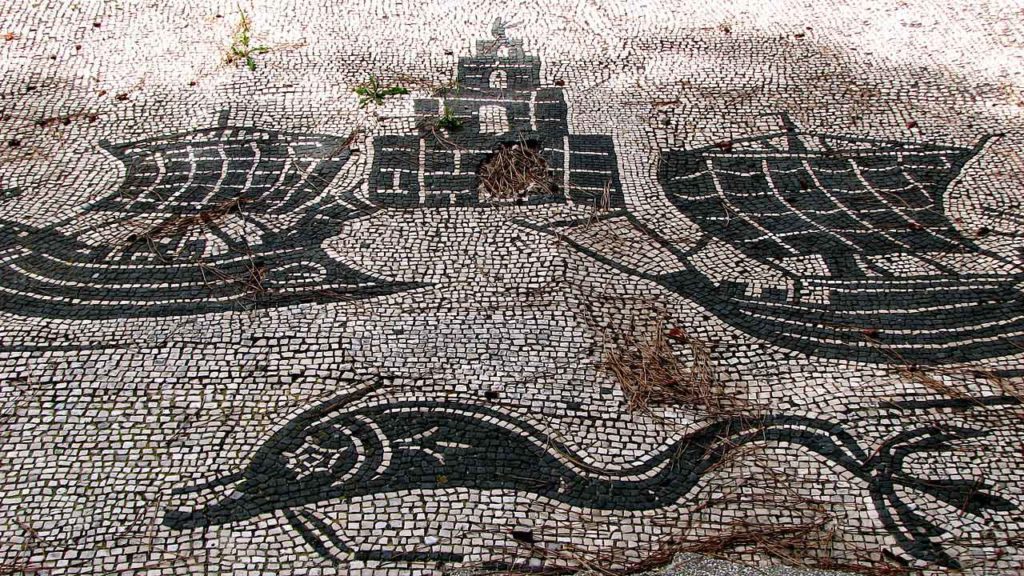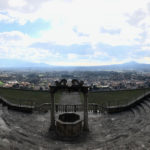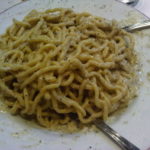Ostia Antica is likely Rome’s most missed and undervalued site by tourists visiting the city.
Easily reached by the local train in just 25 minutes from the Piramide metro station (Ostiense train station), Ostia Antica enchants the imagination of ancient Roman life. The port city was founded in 620 B.C. with both Republic and Empirical elements still identifiable: the ancient road of the Decumanus Maximus (the city’s main road that runs the entire length of the city), the theatre, house of Diana (a typical lower middle class dwelling), and a bar with humble frescoes still visible. Even the public toilets are intact, an intimate room filled with toilets lined up without any privacy between them.
Ostia Antica is often missed by visitors to Rome because it lies outside the historic center. But it is truly a jewel of ancient Rome and absolutely worth the short and convenient train ride. Looking to plan your day excursion to Ostia Antica? Here’s how we would plan the day:
The Perfect Day Trip to Ostia Antica
9 am
Rise and shine to the sweet aromas of morning in Rome! Breakfast in Rome is often a quick meal, with coffee and pastry enjoyed directly at the bar. If you’d like to head right to the Piramide/Ostiense train station, grab a cappuccino and cornetto at a nearby bar. One of our favorites is Pasticceria Andreotti just a few blocks down Via Ostiense. Or if you’re in a hurry, the simple bar at the train station is just fine too.
*If you’re still looking for a place to stay, check out vacation rentals by ROMAC. Conveniently located near the train station the Testaccio apartment was recently updated for up to 5 guests to reflect the cool sensibility of the up-and-coming neighborhood. For a large group, the San Saba vacation rental can accommodate up to 12 guests in 5 bedrooms with 3 full baths and 3 terraces. Both apartments are walking distance to the train station/metro stop as well as a plethora of restaurants and shops in the Piramide and Testaccio neighborhoods.
Now make your way to the train station, get your tickets, and catch your train. The Roma-Lido train runs between the Ostiense train station (same as Piramide metro stop) and Ostia beach every 15 minutes or so. The ticket costs the same as a city metro/bus ticket (cost €1.50, for more information read our blog post about taking public transportation in Rome). Get off at the Ostia Antica stop.
10am
Once you leave the train, follow the signs to the entrance to Ostia Antica. There is a bridge to cross the street, and from the station, it’s about a 10 minute walk.
Entrance tickets to Ostia Antica cost €8 (under 18 are free). Ostia Antica is also part of the circuit of museums and monuments included with your Roma Pass.
For information on guided and audio tours, visit the official website for Ostia Antica. Otherwise, bring a good map with you and explore on your own. Plan to spend several good hours wondering the ruins by following the ancient streets and imagine what life was like here 2,000 years ago.
So what’s not to miss?
Theatre – climb the aisles for an audience perspective of the theatre’s spectacle
Square of the Guilds – walk the entire open square and view the preserved mosaics that served as the store front signs.
Public Baths Complex – spectacular mosaics beautifully viewed from a second story.
House of Diana – a well preserved common dwelling (known as insulae) which house multiple families in tight living quarters
Bar – see the simple sink, shelves that displayed store offerings, and a few surviving frescoes of this ancient tavern and bar
Public Toilets – without any kind of privacy, see what public toilets looked like 2,000 years ago.
1pm
Ostia Antica is not enormously expansive, but there is plenty to see and explore. 2-3 hours is a good amount of time to give yourself to really see everything and leisurely walk the entire city.
After a few hours chances are you’ll work up an appetite. Take a load off and enjoy some lunch. There is a small restaurant near the museum of Ostia Antica for a simple lunch, serving pasta, pizza, etc. Otherwise, leaving Ostia Antica and heading back toward the train you’ll run into the borghetto, a small cluster of restaurants and shops marked by a large fortress, the castello. Sora Margherita al Borghetto is the local favorite, dishing up Roman classics in a rustic trattoria atmosphere.
3pm
Looking for more history of Ostia Antica? Check out the museum which houses most of the statuary and artifacts taken from the excavations of Ostia Antica during the 20th century. Closure of the park depends on the time of year and based on sunset.
If you’re feeling a bit overwhelmed with history and looking for some time to relax and take a walk, head back to the station and catch the train. Take it a few more stops to Lido Centro where you can walk a few blocks to Piazza Anco Marzio pier and beach front for a gelato and to catch some afternoon rays.
6pm
Make your way back to the center of Rome for dinner or aperitivo. From your vacation rental in Testaccio there are plenty of great places within walking distance. Have a look at our list of favorite tourist-free restaurants in Testaccio if that’s what you’re in the mood for. Or walk a few blocks to the world’s largest Eataly, located near the far end of the Ostiense train station and well indicated with signage from the metro station, if your large family can’t decide on what to eat. If you’re looking for something a bit more upscale, try La Fata Ignorante restaurant at Via Giuseppe Giulietti, 5.
Have you taken a day trip to Ostia Antica? Share your experience with us in the comments below!




















[…] Rome’s Ostiense neighborhood is located in the south part of the city, between Testaccio and Garbatella. The neighborhood is also delineated by the Porta San Paolo, a 3rd-century gate in the Aurelian Walls, which is considered the start of Via Ostiense, the road that connects Rome with the ancient port city of Ostia Antica. […]